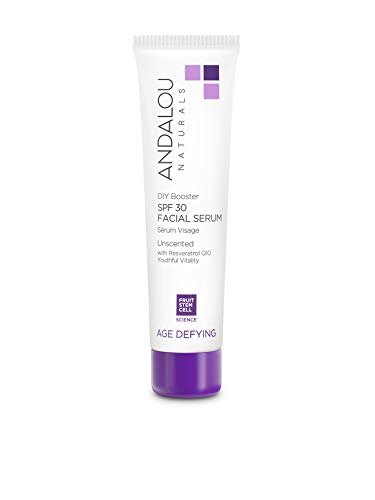

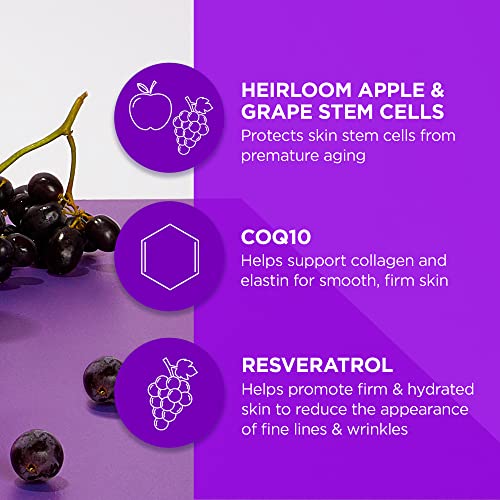
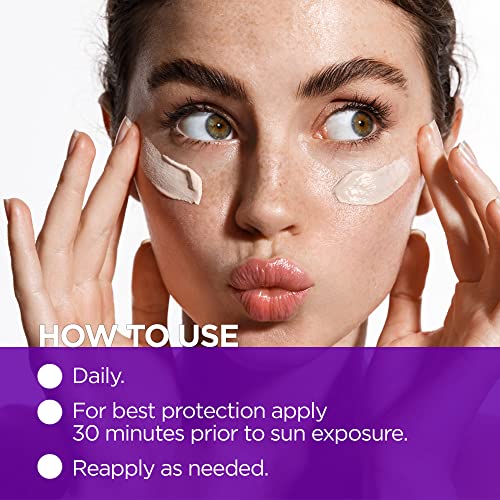
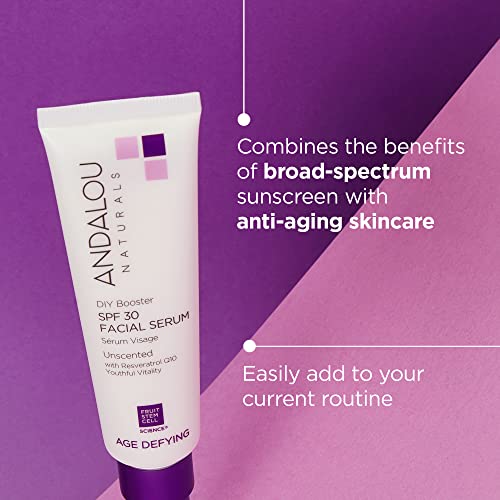
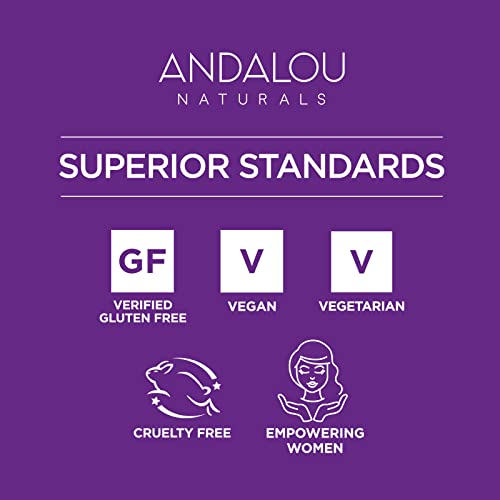
Andalou Naturals Face Sunscreen Serum SPF 30 - Anti-Aging, Broad Spectrum, Moisturizing - 2 Fl Oz


Octinoxate
High RiskOctinoxate is a widely used sunscreen ingredient known for its ability to absorb UV radiation, providing protection against sunburn and skin damage. It is often incorporated into lotions and creams to enhance their effectiveness in shielding the skin from harmful UV rays.
Sustai Insights
Octinoxate effectively serves as a UV filter in sunscreen formulations, contributing to skin protection. However, it raises health concerns, including potential endocrine disruption and low to moderate risks of allergies and neurotoxicity. Environmentally, it has been flagged for its pollutant potential and possible bioaccumulation. Regulatory bodies have issued warnings regarding its use, classifying the overall risk as high. Safe usage practices are advised, and alternatives such as mineral-based sunscreens may offer safer options.
Ubiquinone
Medium RiskUbiquinone, also known as coenzyme Q10, is a naturally occurring antioxidant found in the body, primarily in the mitochondria. It plays a crucial role in energy production and is commonly used in skincare and dietary supplements for its potential health benefits and ability to support cellular function.
Sustai Insights
Ubiquinone provides functional benefits as an antioxidant, aiding in energy production and skin health. It is generally considered safe, with low risks for carcinogenicity, allergies, and immunotoxicity, although moderate concerns exist regarding developmental and reproductive toxicity and certain usage restrictions. Environmental impacts are minimal, with no significant bioaccumulation noted. Regulatory bodies do not impose severe restrictions, but users should adhere to recommended concentrations. Overall, this ingredient presents a medium risk level, and alternatives like alpha-lipoic acid may be considered for those seeking different antioxidant options.
Octisalate
Medium RiskOctisalate is a weak UVB absorber commonly used in sunscreen formulations to enhance sun protection. It functions by absorbing ultraviolet radiation, thereby preventing sunburn and skin damage. This ingredient is often combined with other UV filters to achieve a broad-spectrum protective effect.
Sustai Insights
Octisalate provides effective UVB protection in sun care products, contributing to skin safety by reducing sunburn risk. Its environmental impact is moderate, with some concerns about its potential as an endocrine disruptor and possible restrictions in specific regions. Health risks are generally low, with low to moderate concerns regarding allergies and immunotoxicity. Regulatory bodies have verified its safe use under certain conditions, leading to an overall moderate risk assessment. For safer alternatives, consider mineral-based UV filters or other approved organic compounds.
Phenethyl Alcohol
Medium RiskPhenethyl alcohol is an aromatic alcohol commonly used in cosmetic formulations. It functions primarily as a solvent and a preservative, contributing to product stability and enhancing the fragrance profile.
Sustai Insights
Phenethyl alcohol exhibits functional benefits as a preservative and solvent in cosmetic products, with some sustainability credentials due to its natural origin. However, it is associated with moderate allergy concerns and low risks of carcinogenicity and reproductive toxicity. Regulatory bodies have imposed specific use restrictions, highlighting the need for cautious application. Overall, the risk assessment indicates a medium risk level, warranting safe usage practices and consideration of alternatives like natural preservatives.
Avobenzone
Medium RiskAvobenzone is an organic compound commonly used in sunscreens and skincare products for its ability to absorb ultraviolet (UV) radiation. It provides broad-spectrum protection against UVA rays, helping to prevent skin damage caused by sun exposure. However, it is known to degrade when exposed to sunlight unless stabilized with other ingredients.
Sustai Insights
Avobenzone effectively protects against UVA rays, making it a valuable ingredient in sun care products. However, it has moderate use restrictions due to its instability in sunlight, which can lead to enhanced skin absorption and potential irritation. Regulatory bodies restrict its use in certain formulations, categorizing it as having low concerns for cancer, allergies, and reproductive toxicity. Environmental risks include its potential as a pollutant, though it is not highly bioaccumulative. Overall, the ingredient poses medium risk, and users should adhere to product recommendations for safe application.
Camelina Sativa (Gold Of Pleasure) Seed Oil
Low RiskCamelina sativa (gold of pleasure) seed oil is a fixed oil extracted from the seeds of the Camelina sativa plant. It is primarily used in cosmetic formulations for its emollient properties, providing hydration and skin barrier support.
Sustai Insights
Camelina sativa seed oil offers functional benefits as a moisturizer and skin conditioner, being sustainably sourced and biodegradable. Health risks are low, with minimal concerns regarding carcinogenicity, allergy, and irritation. Environmental risks are also low, and regulatory bodies have not imposed significant restrictions. Safe usage practices should be followed, with no notable alternatives required, reflecting an overall low risk assessment.
Resveratrol
Low RiskResveratrol is a natural polyphenolic compound found in various plants, notably in the skin of grapes. It is commonly used in cosmetic formulations for its antioxidant properties and potential to enhance skin health. Its primary function in products includes acting as a stabilizer and providing skin protection.
Sustai Insights
Resveratrol offers functional benefits as a powerful antioxidant, potentially enhancing skin health and providing environmental protection. It poses low health risks, with minimal concerns regarding carcinogenicity, allergies, and reproductive toxicity. Environmental risks appear low, with no evidence of bioaccumulation. Regulatory bodies do not currently restrict its use. Overall, it presents a low-risk profile, making it a suitable ingredient with no significant safety concerns.
Tocopherol, D Alpha
Low RiskTocopherol, specifically d-alpha tocopherol, is a naturally occurring form of Vitamin E. It is commonly used in cosmetic and personal care products primarily for its antioxidant properties, helping to protect formulations from oxidation and extend shelf life.
Sustai Insights
D-alpha tocopherol provides effective antioxidant benefits, contributing to product stability. It is sustainably sourced and generally regarded as safe, with low concerns regarding carcinogenicity, allergies, and reproductive toxicity. However, there are minor concerns about endocrine disruption. Regulatory bodies have not imposed significant restrictions, indicating low overall risk. Recommended usage practices include adhering to established safe concentration thresholds. Alternatives, such as other forms of Vitamin E or plant-based antioxidants, may also be considered.
Aspalathus Linearis (Rooibos) Extract
Low RiskAspalathus linearis extract is derived from the leaves of the rooibos plant, commonly used in beverages and cosmetic products for its antioxidant properties and potential skin benefits. It is known for its high content of flavonoids, which contribute to its functional role in formulations.
Sustai Insights
Aspalathus linearis extract offers functional benefits such as antioxidant properties and skin soothing effects, making it a valuable ingredient in cosmetics. It is sustainably sourced and poses low health risks, including negligible concerns for carcinogenicity and allergies. Environmental risks are minimal, with no significant pollutants or bioaccumulation issues. Regulatory assessments indicate no restrictions, reflecting its safe use in various applications. Overall, it is assessed as low risk, with no substantial adverse effects noted, making it a suitable choice for consumers.
Sorbitan Oleate Decylglucoside Crosspolymer
Low RiskSorbitan oleate decylglucoside crosspolymer is a synthetic polymer derived from sorbitan oleate and decylglucoside. It functions primarily as an emulsifier and thickening agent in cosmetic and personal care products, aiding in the stabilization of formulations and improving texture.
Sustai Insights
Sorbitan oleate decylglucoside crosspolymer offers functional benefits as an effective emulsifier and stabilizer, enhancing product consistency. It has low health risk concerns related to carcinogenicity, allergenic potential, and reproductive toxicity. Environmentally, it presents low bioaccumulation and pollution risks. Regulatory bodies do not impose restrictions on its use. Overall, its risk level is assessed as low, making it a suitable ingredient in formulations.
Cetyl Alcohol
Low RiskCetyl alcohol is a long-chain organic alcohol commonly used in cosmetic formulations. It serves as an emollient, emulsifier, and thickening agent, enhancing the texture and stability of products. Cetyl alcohol is derived from natural sources, such as coconut or palm oil, and is often included in creams, lotions, and hair conditioners.
Sustai Insights
Cetyl alcohol offers functional benefits as an emollient and emulsifier, improving product texture and stability. It is biodegradable and sourced from renewable materials, contributing to sustainability. Health risks are minimal, with low concerns for carcinogenicity, allergies, or reproductive toxicity. Environmental impact is also low, with no significant pollutant or bioaccumulation potential. Regulatory bodies have not placed restrictions on its use, indicating a favorable safety profile. Overall, cetyl alcohol is assessed as low risk, and safe usage practices include ensuring proper formulation concentrations.
Zea Mays (Corn)
Low RiskZea mays (corn) fruit is derived from the plant Zea mays. It is commonly used in various cosmetic formulations for its functional properties, including acting as a humectant and providing texture in products.
Sustai Insights
Zea mays offers functional benefits such as moisture retention and improved product texture. It is considered safe with low health risks, including minimal concerns regarding carcinogenicity, allergies, or reproductive toxicity. Environmentally, it poses low risks, with no significant pollutant or bioaccumulation potential. Regulatory assessments do not indicate any restrictions. Overall, the ingredient is assessed as low risk, making it a viable option in cosmetic formulations.
Stearyl Alcohol
Low RiskStearyl alcohol is a compound produced from the hydrogenation of stearic acid, commonly used in cosmetic formulations as an emulsifier and thickening agent. It helps stabilize products by blending oil and water phases, enhancing texture and consistency.
Sustai Insights
Stearyl alcohol provides functional benefits as an emulsifier and stabilizer, contributing to improved product texture. It is generally regarded as safe with low concerns for cancer, allergies, and reproductive toxicity. However, it may cause moderate skin, eye, or respiratory irritation. Regulatory bodies do not impose significant restrictions, indicating a low overall risk. While it poses minimal health and environmental hazards, caution is advised for sensitive individuals. Alternatives like cetyl alcohol or plant-based emulsifiers may offer safer options for formulators.
Starch
Low RiskStarch is a carbohydrate commonly derived from sources such as corn, wheat, or potatoes. It serves primarily as a thickening agent, stabilizer, or emulsifier in various food and cosmetic products, contributing to texture and consistency without imparting strong flavors or colors.
Sustai Insights
Starch offers functional benefits like effective thickening and stabilizing in formulations. It is considered low risk for health concerns, with minimal allergenic potential and no known carcinogenic effects. Environmentally, starch is biodegradable and typically sustainably sourced. Regulatory bodies, including the FDA, have not imposed significant restrictions. Overall, the risk associated with starch is low, and it is suitable for various applications, with no major health or environmental concerns noted.
Ethylhexylglycerin
Low RiskEthylhexylglycerin is a glyceryl ether utilized primarily as a skin-conditioning agent and preservative in cosmetic formulations. It enhances the efficacy of preservatives and serves as a humectant, helping to retain moisture in the skin. This ingredient is commonly found in various personal care products.
Sustai Insights
Ethylhexylglycerin offers functional benefits as an effective preservative and skin-conditioning agent, contributing to product longevity and moisture retention. Health risks are generally low, with minor concerns regarding allergic contact dermatitis and irritant potential. Environmentally, it poses minimal risks, not being recognized as a pollutant or bioaccumulative. Regulatory bodies have imposed few restrictions, indicating its safety for use. Overall, its risk level is assessed as low, making it a viable option in cosmetic formulations. For those seeking alternatives, ingredients like propanediol may serve similar functions with potentially lower irritation profiles.
Hibiscus Sabdariffa (Roselle) Flower Extract
Low RiskHibiscus sabdariffa (roselle) flower extract is derived from the calyx of the hibiscus plant, used primarily for its potential antioxidant properties and as a natural colorant in various cosmetic and food products.
Sustai Insights
Hibiscus sabdariffa flower extract offers functional benefits such as antioxidant properties and natural coloring, while being sustainably sourced with low environmental impact. Health risks, including irritant potential, are minimal, and it is not classified as a carcinogen or allergen. Regulatory status is favorable, with no current restrictions. Overall, the risk level is assessed as low, making it a safe choice in formulations.
Camelina Sativa (Gold Of Pleasure) Seed Oil
Low RiskCamelina sativa (gold of pleasure) seed oil is a fixed oil extracted from the seeds of the Camelina sativa plant. It is primarily used in cosmetic formulations for its emollient properties, providing hydration and skin barrier support.
Sustai Insights
Camelina sativa seed oil offers functional benefits as a moisturizer and skin conditioner, being sustainably sourced and biodegradable. Health risks are low, with minimal concerns regarding carcinogenicity, allergy, and irritation. Environmental risks are also low, and regulatory bodies have not imposed significant restrictions. Safe usage practices should be followed, with no notable alternatives required, reflecting an overall low risk assessment.
Ubiquinone
Medium RiskUbiquinone, also known as coenzyme Q10, is a naturally occurring antioxidant found in the body, primarily in the mitochondria. It plays a crucial role in energy production and is commonly used in skincare and dietary supplements for its potential health benefits and ability to support cellular function.
Sustai Insights
Ubiquinone provides functional benefits as an antioxidant, aiding in energy production and skin health. It is generally considered safe, with low risks for carcinogenicity, allergies, and immunotoxicity, although moderate concerns exist regarding developmental and reproductive toxicity and certain usage restrictions. Environmental impacts are minimal, with no significant bioaccumulation noted. Regulatory bodies do not impose severe restrictions, but users should adhere to recommended concentrations. Overall, this ingredient presents a medium risk level, and alternatives like alpha-lipoic acid may be considered for those seeking different antioxidant options.
Resveratrol
Low RiskResveratrol is a natural polyphenolic compound found in various plants, notably in the skin of grapes. It is commonly used in cosmetic formulations for its antioxidant properties and potential to enhance skin health. Its primary function in products includes acting as a stabilizer and providing skin protection.
Sustai Insights
Resveratrol offers functional benefits as a powerful antioxidant, potentially enhancing skin health and providing environmental protection. It poses low health risks, with minimal concerns regarding carcinogenicity, allergies, and reproductive toxicity. Environmental risks appear low, with no evidence of bioaccumulation. Regulatory bodies do not currently restrict its use. Overall, it presents a low-risk profile, making it a suitable ingredient with no significant safety concerns.
Tocopherol, D Alpha
Low RiskTocopherol, specifically d-alpha tocopherol, is a naturally occurring form of Vitamin E. It is commonly used in cosmetic and personal care products primarily for its antioxidant properties, helping to protect formulations from oxidation and extend shelf life.
Sustai Insights
D-alpha tocopherol provides effective antioxidant benefits, contributing to product stability. It is sustainably sourced and generally regarded as safe, with low concerns regarding carcinogenicity, allergies, and reproductive toxicity. However, there are minor concerns about endocrine disruption. Regulatory bodies have not imposed significant restrictions, indicating low overall risk. Recommended usage practices include adhering to established safe concentration thresholds. Alternatives, such as other forms of Vitamin E or plant-based antioxidants, may also be considered.
Aspalathus Linearis (Rooibos) Extract
Low RiskAspalathus linearis extract is derived from the leaves of the rooibos plant, commonly used in beverages and cosmetic products for its antioxidant properties and potential skin benefits. It is known for its high content of flavonoids, which contribute to its functional role in formulations.
Sustai Insights
Aspalathus linearis extract offers functional benefits such as antioxidant properties and skin soothing effects, making it a valuable ingredient in cosmetics. It is sustainably sourced and poses low health risks, including negligible concerns for carcinogenicity and allergies. Environmental risks are minimal, with no significant pollutants or bioaccumulation issues. Regulatory assessments indicate no restrictions, reflecting its safe use in various applications. Overall, it is assessed as low risk, with no substantial adverse effects noted, making it a suitable choice for consumers.
Sorbitan Oleate Decylglucoside Crosspolymer
Low RiskSorbitan oleate decylglucoside crosspolymer is a synthetic polymer derived from sorbitan oleate and decylglucoside. It functions primarily as an emulsifier and thickening agent in cosmetic and personal care products, aiding in the stabilization of formulations and improving texture.
Sustai Insights
Sorbitan oleate decylglucoside crosspolymer offers functional benefits as an effective emulsifier and stabilizer, enhancing product consistency. It has low health risk concerns related to carcinogenicity, allergenic potential, and reproductive toxicity. Environmentally, it presents low bioaccumulation and pollution risks. Regulatory bodies do not impose restrictions on its use. Overall, its risk level is assessed as low, making it a suitable ingredient in formulations.
Octisalate
Medium RiskOctisalate is a weak UVB absorber commonly used in sunscreen formulations to enhance sun protection. It functions by absorbing ultraviolet radiation, thereby preventing sunburn and skin damage. This ingredient is often combined with other UV filters to achieve a broad-spectrum protective effect.
Sustai Insights
Octisalate provides effective UVB protection in sun care products, contributing to skin safety by reducing sunburn risk. Its environmental impact is moderate, with some concerns about its potential as an endocrine disruptor and possible restrictions in specific regions. Health risks are generally low, with low to moderate concerns regarding allergies and immunotoxicity. Regulatory bodies have verified its safe use under certain conditions, leading to an overall moderate risk assessment. For safer alternatives, consider mineral-based UV filters or other approved organic compounds.
Cetyl Alcohol
Low RiskCetyl alcohol is a long-chain organic alcohol commonly used in cosmetic formulations. It serves as an emollient, emulsifier, and thickening agent, enhancing the texture and stability of products. Cetyl alcohol is derived from natural sources, such as coconut or palm oil, and is often included in creams, lotions, and hair conditioners.
Sustai Insights
Cetyl alcohol offers functional benefits as an emollient and emulsifier, improving product texture and stability. It is biodegradable and sourced from renewable materials, contributing to sustainability. Health risks are minimal, with low concerns for carcinogenicity, allergies, or reproductive toxicity. Environmental impact is also low, with no significant pollutant or bioaccumulation potential. Regulatory bodies have not placed restrictions on its use, indicating a favorable safety profile. Overall, cetyl alcohol is assessed as low risk, and safe usage practices include ensuring proper formulation concentrations.
Zea Mays (Corn)
Low RiskZea mays (corn) fruit is derived from the plant Zea mays. It is commonly used in various cosmetic formulations for its functional properties, including acting as a humectant and providing texture in products.
Sustai Insights
Zea mays offers functional benefits such as moisture retention and improved product texture. It is considered safe with low health risks, including minimal concerns regarding carcinogenicity, allergies, or reproductive toxicity. Environmentally, it poses low risks, with no significant pollutant or bioaccumulation potential. Regulatory assessments do not indicate any restrictions. Overall, the ingredient is assessed as low risk, making it a viable option in cosmetic formulations.
Stearyl Alcohol
Low RiskStearyl alcohol is a compound produced from the hydrogenation of stearic acid, commonly used in cosmetic formulations as an emulsifier and thickening agent. It helps stabilize products by blending oil and water phases, enhancing texture and consistency.
Sustai Insights
Stearyl alcohol provides functional benefits as an emulsifier and stabilizer, contributing to improved product texture. It is generally regarded as safe with low concerns for cancer, allergies, and reproductive toxicity. However, it may cause moderate skin, eye, or respiratory irritation. Regulatory bodies do not impose significant restrictions, indicating a low overall risk. While it poses minimal health and environmental hazards, caution is advised for sensitive individuals. Alternatives like cetyl alcohol or plant-based emulsifiers may offer safer options for formulators.
Phenethyl Alcohol
Medium RiskPhenethyl alcohol is an aromatic alcohol commonly used in cosmetic formulations. It functions primarily as a solvent and a preservative, contributing to product stability and enhancing the fragrance profile.
Sustai Insights
Phenethyl alcohol exhibits functional benefits as a preservative and solvent in cosmetic products, with some sustainability credentials due to its natural origin. However, it is associated with moderate allergy concerns and low risks of carcinogenicity and reproductive toxicity. Regulatory bodies have imposed specific use restrictions, highlighting the need for cautious application. Overall, the risk assessment indicates a medium risk level, warranting safe usage practices and consideration of alternatives like natural preservatives.
Octinoxate
High RiskOctinoxate is a widely used sunscreen ingredient known for its ability to absorb UV radiation, providing protection against sunburn and skin damage. It is often incorporated into lotions and creams to enhance their effectiveness in shielding the skin from harmful UV rays.
Sustai Insights
Octinoxate effectively serves as a UV filter in sunscreen formulations, contributing to skin protection. However, it raises health concerns, including potential endocrine disruption and low to moderate risks of allergies and neurotoxicity. Environmentally, it has been flagged for its pollutant potential and possible bioaccumulation. Regulatory bodies have issued warnings regarding its use, classifying the overall risk as high. Safe usage practices are advised, and alternatives such as mineral-based sunscreens may offer safer options.
Avobenzone
Medium RiskAvobenzone is an organic compound commonly used in sunscreens and skincare products for its ability to absorb ultraviolet (UV) radiation. It provides broad-spectrum protection against UVA rays, helping to prevent skin damage caused by sun exposure. However, it is known to degrade when exposed to sunlight unless stabilized with other ingredients.
Sustai Insights
Avobenzone effectively protects against UVA rays, making it a valuable ingredient in sun care products. However, it has moderate use restrictions due to its instability in sunlight, which can lead to enhanced skin absorption and potential irritation. Regulatory bodies restrict its use in certain formulations, categorizing it as having low concerns for cancer, allergies, and reproductive toxicity. Environmental risks include its potential as a pollutant, though it is not highly bioaccumulative. Overall, the ingredient poses medium risk, and users should adhere to product recommendations for safe application.
Starch
Low RiskStarch is a carbohydrate commonly derived from sources such as corn, wheat, or potatoes. It serves primarily as a thickening agent, stabilizer, or emulsifier in various food and cosmetic products, contributing to texture and consistency without imparting strong flavors or colors.
Sustai Insights
Starch offers functional benefits like effective thickening and stabilizing in formulations. It is considered low risk for health concerns, with minimal allergenic potential and no known carcinogenic effects. Environmentally, starch is biodegradable and typically sustainably sourced. Regulatory bodies, including the FDA, have not imposed significant restrictions. Overall, the risk associated with starch is low, and it is suitable for various applications, with no major health or environmental concerns noted.
Ethylhexylglycerin
Low RiskEthylhexylglycerin is a glyceryl ether utilized primarily as a skin-conditioning agent and preservative in cosmetic formulations. It enhances the efficacy of preservatives and serves as a humectant, helping to retain moisture in the skin. This ingredient is commonly found in various personal care products.
Sustai Insights
Ethylhexylglycerin offers functional benefits as an effective preservative and skin-conditioning agent, contributing to product longevity and moisture retention. Health risks are generally low, with minor concerns regarding allergic contact dermatitis and irritant potential. Environmentally, it poses minimal risks, not being recognized as a pollutant or bioaccumulative. Regulatory bodies have imposed few restrictions, indicating its safety for use. Overall, its risk level is assessed as low, making it a viable option in cosmetic formulations. For those seeking alternatives, ingredients like propanediol may serve similar functions with potentially lower irritation profiles.
Hibiscus Sabdariffa (Roselle) Flower Extract
Low RiskHibiscus sabdariffa (roselle) flower extract is derived from the calyx of the hibiscus plant, used primarily for its potential antioxidant properties and as a natural colorant in various cosmetic and food products.
Sustai Insights
Hibiscus sabdariffa flower extract offers functional benefits such as antioxidant properties and natural coloring, while being sustainably sourced with low environmental impact. Health risks, including irritant potential, are minimal, and it is not classified as a carcinogen or allergen. Regulatory status is favorable, with no current restrictions. Overall, the risk level is assessed as low, making it a safe choice in formulations.
Experience the dual benefits of hydration and sun protection with Andalou Naturals DIY Booster SPF 30 Facial Serum. This unscented, anti-aging serum combines a fruit stem cell complex with broad-spectrum SPF 30, ideal for dry to very dry skin.
- Multi-Functional Formula: This serum not only shields against UVA/UVB rays but also enhances skin vitality, promoting a firmer complexion.
- Versatile Application: Seamlessly blend it with your favorite moisturizer for an effortless sun protection boost, perfect for daily use alone or under makeup.
- Nature-Derived Ingredients: Crafted with 98% nature-derived components, this vegan and cruelty-free serum supports a healthier planet while caring for your skin.
- Daily Defense: Designed for daily application, it’s easy to use—just apply liberally 15 minutes before sun exposure, and reapply as necessary.
- Community-Conscious Brand: Andalou Naturals emphasizes ethical practices, ensuring that every product is free from harmful additives, making it a trusted choice for health-conscious consumers.
Subscribe & Save with Sustai
- Best Price Guarantee: Always enjoy the lowest prices on sustainable home essentials.
- No Surprises: We’ll notify you before shipping. No hidden fees, ever.
- You’re in Charge: Change, pause, or cancel your subscription anytime with ease.
- Eco-Friendly Deliveries: Our grouped shipments mean less packaging and lower emissions.
Join us on a sustainable journey. Special offers for a limited time! Prices and promotions may change.
Recommended Products
Experience the dual benefits of hydration and sun protection with Andalou Naturals DIY Booster SPF 30 Facial Serum. This unscented, anti-aging serum combines a fruit stem cell complex with broad-spectrum SPF 30, ideal for dry to very dry skin.
- Multi-Functional Formula: This serum not only shields against UVA/UVB rays but also enhances skin vitality, promoting a firmer complexion.
- Versatile Application: Seamlessly blend it with your favorite moisturizer for an effortless sun protection boost, perfect for daily use alone or under makeup.
- Nature-Derived Ingredients: Crafted with 98% nature-derived components, this vegan and cruelty-free serum supports a healthier planet while caring for your skin.
- Daily Defense: Designed for daily application, it’s easy to use—just apply liberally 15 minutes before sun exposure, and reapply as necessary.
- Community-Conscious Brand: Andalou Naturals emphasizes ethical practices, ensuring that every product is free from harmful additives, making it a trusted choice for health-conscious consumers.

You can have at most 2 Sustainable Steals products in your cart
Customer Reviews
Customers’ View
Customers generally express satisfaction with the dual functionality of this sunscreen serum, appreciating its lightweight and moisturizing formula that works well under makeup. Users highlight its effectiveness in providing broad-spectrum sun protection without feeling greasy, making it suitable for daily use. The product's natural and cruelty-free ingredients resonate with environmentally and health-conscious consumers, with many noting its pleasant, subtle scent. However, some customers suggest improvements, such as opting for more sustainable packaging. Overall, customers find this product to be a reliable addition to their skincare routine, aligning with their values of health and sustainability.
AI-generated from the text of customer reviewsThis product has no reviews yet.




